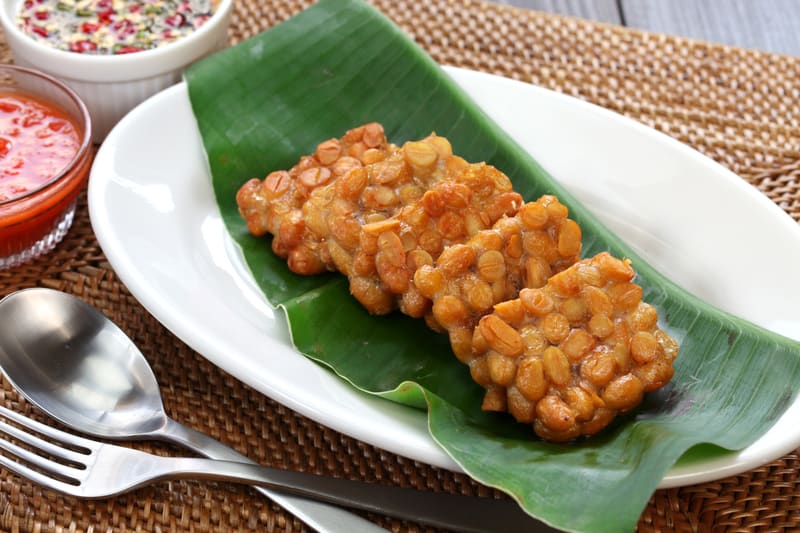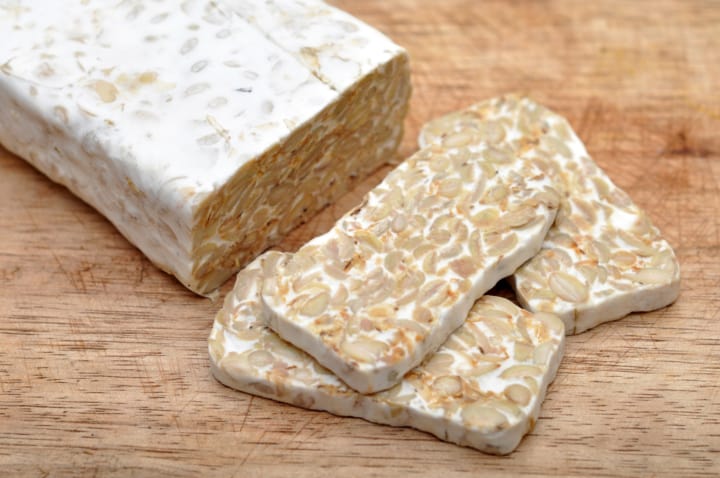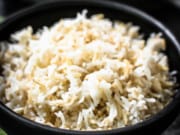If you're considering a plant-based lifestyle, you're probably heard about tempeh. We're answering the big questions: what is tempeh, how is it made, and what are the facts about tempeh nutrition? We've got answers.
Article Courtesy: Andrew Steingrube
Meat can be a wonderful thing. Ask any traditional omnivorous human being his or her opinion on meat, and chances are that they will tell you they can’t live without it. In a sense they’re right, we are all here in part because our ancestors had access to meat. Our very dental structure indicates that meat has been a part of the human diet for a very long time, and the large amounts of protein found in meat are thought to have fueled the evolution of both our brain and body. But if you are living a vegetarian lifestyle, the Indonesians may have developed the best meat alternative the world has ever seen. It's called tempeh.
What Is Tempeh?
Tempeh (pronounced tem-pay) is a fermented soy bean cake that originated in Indonesia and has been around for at least a couple hundred years. It is mostly unknown in the United States, but it is becoming more popular here especially amongst the vegetarian community. It is also typically gluten-free, so if you are a G-free vegetarian, then you should probably run to the store, load up on tempeh, and finish reading this article later.
How Tempeh is made:
Ok, welcome back. Hope the traffic wasn’t too bad and the lines weren’t too long. So now that you’ve emptied your wallet and filled your fridge with tempeh, what exactly is it? Tempeh is made by starting with whole soy beans, soaking them, and then partially cooking them. Then Rhizopus molds are added, which ferments the soybeans. The beans are then spread into a cake-like shape and allowed to ferment for a day or two. This fermentation process helps produce both tempeh’s nutty and mushroom-like flavor as well as its firm texture. The molds even reduce levels of oligosaccharides, the carbohydrates in soy that can produce gas and indigestion.
About Tempeh Nutrition:
But does tempeh pass the nutritional sniff-test? Yes. In fact, it comes out smelling like roses (not literally, but I digress). Unlike tofu, which is more processed than tempeh, tempeh uses the entire soybean. This means that tempeh is about 50% higher in protein than tofu. Also because it utilizes the whole soybean, tempeh is much higher in dietary fiber than tofu. But the nutritional benefits don’t end there. Tempeh also contains significant amounts of essential fatty acids, calcium, iron, and other vitamins and minerals. Soy products also all contain soy isoflavones, naturally occurring organic compounds that may provide antioxidant benefits and help fight cancer and heart disease.

TL:DR - Nutrition:
Nutritionally, tempeh really shines. Especially for vegetarians, tempeh’s high protein content, and the fact that it is a complete protein containing all 8 essential amino acids, makes it a great nutritional choice. And since it has more protein than tofu, as well as more fiber and a more palatable taste and texture, tempeh really outshines tofu in almost every aspect.
Is Tempeh Gluten-Free?
So we know tempeh is a great choice if you’re meat-free, but what about if you’re gluten-free as well? Whereas many meat substitutes and imitation meat products do contain gluten, most tempehs do not. As always, read labels and make sure you don’t see gluten-containing ingredients on the package. Some tempehs do add grains which may contain gluten, but most do not. Several gluten-free brands of tempeh should be available at your local supermarket and are most likely obviously labeled as such.
It's versatile from a culinary perspective too:
For meat-free and gluten-free individuals, it's probably time to make tempeh part of your diet, if not a staple. Very high in protein, fiber, vitamins, and minerals, tempeh is a superb nutritional choice especially for vegetarians. And with its firm, nougat-like texture, and earthy flavor, it also shines from a culinary perspective. A very versatile ingredient, tempeh can replace meat in almost any recipe, from sandwiches to soups and salads, stir-frys, chilis and stews, and everything in between. So ultimately okay, I do say that today is a good day to pay for some tempeh, and make it a mainstay of your day-to-day, gluten-free and meat-free diet.

Now you're ready to use it! Swap tempeh for tofu in this Pad Thai recipe.
If you're looking for a tasty and healthy meal that's sure to impress, look no further than this delicious recipe for Pad Thai from the Kitirattragarn family, founders of Dang Foods.








Let Us Know What You Think